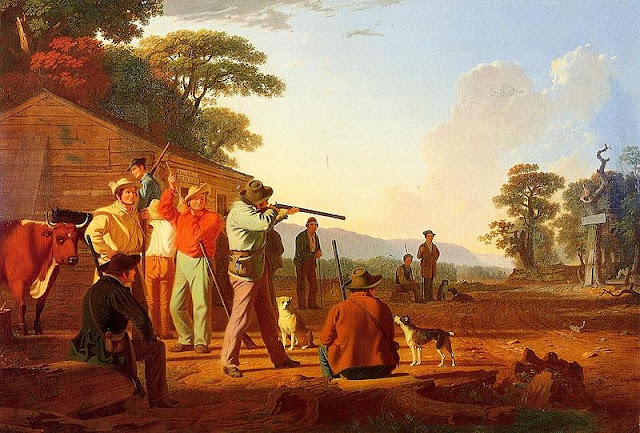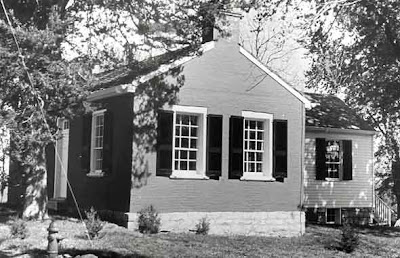 |
| Self Portrait of the Artist |
March 20, 2011 was the 200th birthday of a famous Missouri artist named George Caleb Bingham. I think that 200 is a fine age to be, and it should be celebrated in a big way, unless you are already dead, which I'm sorry to say, is the case with Mr. Bingham. But even though he is not here to do his own celebrating, lots of other people have been thinking about him and looking at his artwork and doing all sorts of Bingham-y things this year.
 |
| Shooting for the Beef There are FOUR dogs in this picture! |
So anyway, that's why Mom and Aunt LaDene went to see an exhibit yesterday of paintings by George Caleb Bingham. And this exhibit was at the Truman Presidential Library and Museum, which is in Independence. Mom and Aunt LaDene liked seeing the paintings, and after Mom told me that Mr. Bingham puts dogs in his paintings sometimes, I looked him up on the internet and sure enough, there were a bunch of paintings with dogs in them!
 |
| Daniel Boone Escorting Settlers Through Cumberland Gap |
One reason why Mr. Bingham maybe liked to put dogs in his paintings is because he painted pictures of life on the frontier along the Missouri River, and a lot of people who lived there probably had dogs. And I also hope that Mr. Bingham just happened to like dogs.
 |
| View of Pike's Peak I think the man would not enjoy the view as much if he didn't have his trusty dog with him! |
Anyway, George Caleb Bingham was born in Augusta County, Virginia, and he was the second of seven children. When he was 7 years old, his father lost a bunch of money, and the family moved to Franklin, Missouri, which is near the middle of the state. Missouri was kind of unsettled back then, so land was cheap. After George's father died of malaria at the age of 38, George's mother opened a school for girls. George worked as a janitor in the school, and then when he was 16, he became an apprentice with a cabinet-maker.
 |
| Fur Traders Descending the Missouri That black animal really, really looks like a cat to me, but Wikipedia says it is a bear cub. |
For a while, Mr. Bingham thought about being a minister, but then he started painting portraits. He found out he could sell these for $20 apiece, and he could paint them pretty fast, like one every day. So he was able to support himself just by painting. He never had any kind of art lessons. He just taught himself how to paint. His style is called luminism, which is a word that art critics use to talk about some American paintings that were made during the 1850s through the 1870s. Artists who use this style paint landscapes that have a lot of light in them. They often have a hazy sky and water that reflects the sky and mountains. When you look at these paintings, you feel happy and calm.
 |
| Eliza Thomas Bingham |
Mr. Bingham had three different wives, but not all at the same time. He and his first wife, Sarah, lived in Arrow Rock, Missouri. They were married for 12 years, had 4 children, and then she died in 1848 when she was only 29. The second Mrs. Bingham was named Eliza, and she was married to George Bingham for 27 years. But sadly, she ended up having to go live in a mental asylum, and she died there in 1876. Mr. Bingham's third wife was Martha Lykins, and she lived 11 years longer than he did. They are both buried in Kansas City at Union Cemetery.
 |
| The Bingham house in Arrow Rock |
The Bingham family moved to St. Louis in 1845, and in 1848 Mr. Bingham got elected to the Missouri General Assembly. You could tell that he was interested in politics because he liked to paint pictures of political subjects such as candidates giving speeches and people going to vote. Most of these political paintings have dogs in them, so that makes them pretty interesting, in my opinion.
 |
| Stump Speaking |
In 1856, Mr. Bingham, his second wife Eliza, and his youngest daughter went to Europe. First they lived in Paris and later in Germany, where Mr. Bingham met lots of artists and studied the works of old painters who were already dead by then.
When they got back to America, Mr. Bingham started painting more portraits, because that was the best way for him to make money to live on. Also he got into politics again, and during the Civil War years, he served as State Treasurer of Missouri. In 1874, he was appointed president of the Kansas City Board of Police Commissioners, and he was also appointed as the first Chief of Police. Then in 1875, the governor appointed Mr. Bingham the Adjutant-General of Missouri, and after that, people liked to call him General Bingham.
 |
| Washington Crossing the Delaware |
George Caleb Bingham died on July 7, 1879. Not long before he died, he became the first Professor of Art at the University of Missouri in Columbia. But he was already very sick by then, so he was only able to see a few students before he died.
 |
| A photo of George Caleb Bingham later in his life |
Mr. Bingham almost never signed his paintings, and he didn't keep any kind of record of them, so it's hard to know what he painted and what he didn't paint. There are over 500 pieces that the art experts now think were definitely painted by Mr. Bingham, and 460 of them are portraits. After he first died, people sort of forgot about him, but then in the 1930s, his work got popular again, and now he is thought of as one of the greatest American painters of the 19th century.
 |
| Horse Thief People only just recently figured out that Mr. Bingham painted this. |
I think it's good that Mr. Bingham put dogs in some of his paintings, but I think he could have put even more in. And when he was doing all those portraits, he could have let people pose with their dogs. Or better yet, he could have painted portraits of just the dogs without the people, like Maud Earl did. If Mr. Bingham had done that, he could have been a truly perfect American artist!
No comments:
Post a Comment